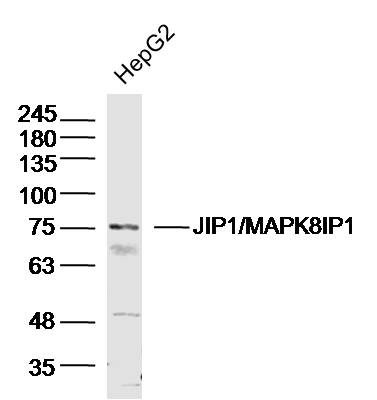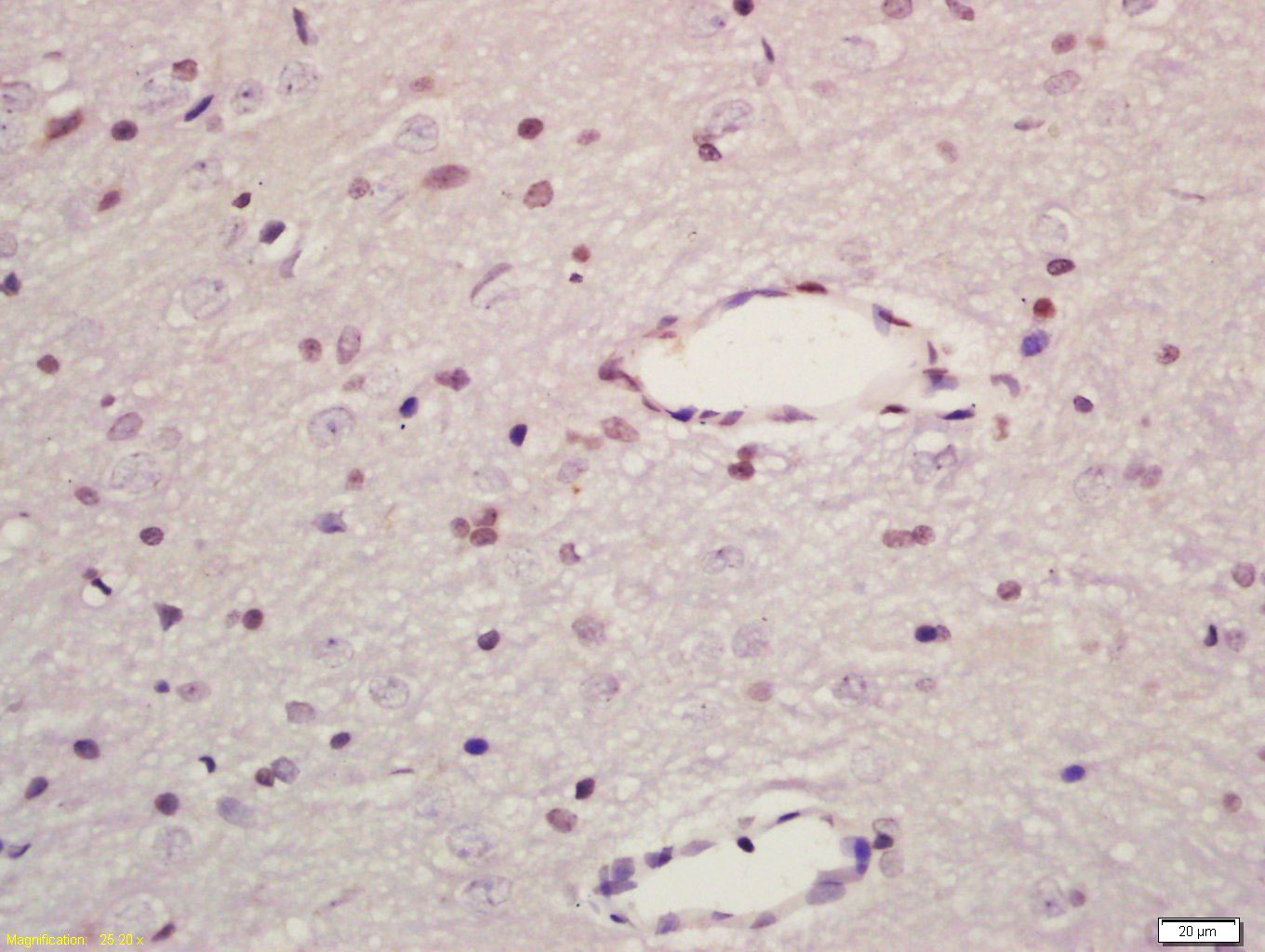
Rabbit Anti-JIP1/MAPK8IP1 antibody
C jun amino terminal kinase interacting protein 1; IB 1; IB1; Islet brain 1; JIP 1; JNK interacting protein 1; JNK MAP kinase scaffold protein 1; MAPK8IP 1; MAPK8IP1; Mitogen activated protein kinase 8 interacting protein 1; PRKM8 interacting protein; PRK
View History [Clear]
Details
Product Name JIP1/MAPK8IP1 Chinese Name 丝裂原活化蛋白激酶8相互作用蛋白1抗体 Alias C jun amino terminal kinase interacting protein 1; IB 1; IB1; Islet brain 1; JIP 1; JNK interacting protein 1; JNK MAP kinase scaffold protein 1; MAPK8IP 1; MAPK8IP1; Mitogen activated protein kinase 8 interacting protein 1; PRKM8 interacting protein; PRKM8IP; JIP1_HUMAN. Research Area Tumour Signal transduction Kinases and Phosphatases Cytoskeleton Immunogen Species Rabbit Clonality Polyclonal React Species Human, Rat, (predicted: Mouse, Dog, Pig, Cow, Horse, Sheep, ) Applications WB=1:500-2000 ELISA=1:5000-10000 IHC-P=1:100-500 IHC-F=1:100-500 IF=1:100-500 (Paraffin sections need antigen repair)
not yet tested in other applications.
optimal dilutions/concentrations should be determined by the end user.Theoretical molecular weight 77kDa Cellular localization The nucleus cytoplasmic The cell membrane Extracellular matrix Form Liquid Concentration 1mg/ml immunogen KLH conjugated synthetic peptide derived from human JIP1/MAPK8IP1: 425-524/711 Lsotype IgG Purification affinity purified by Protein A Buffer Solution 0.01M TBS(pH7.4) with 1% BSA, 0.03% Proclin300 and 50% Glycerol. Storage Shipped at 4℃. Store at -20 °C for one year. Avoid repeated freeze/thaw cycles. Attention This product as supplied is intended for research use only, not for use in human, therapeutic or diagnostic applications. PubMed PubMed Product Detail This gene encodes a regulator of the pancreatic beta-cell function. It is highly similar to JIP-1, a mouse protein known to be a regulator of c-Jun amino-terminal kinase (Mapk8). This protein has been shown to prevent MAPK8 mediated activation of transcription factors, and to decrease IL-1 beta and MAP kinase kinase 1 (MEKK1) induced apoptosis in pancreatic beta cells. This protein also functions as a DNA-binding transactivator of the glucose transporter GLUT2. RE1-silencing transcription factor (REST) is reported to repress the expression of this gene in insulin-secreting beta cells. This gene is found to be mutated in a type 2 diabetes family, and thus is thought to be a susceptibility gene for type 2 diabetes.
Function:
The JNK-interacting protein (JIP) group of scaffold proteins selectively mediates JNK signaling by aggregating specific components of the MAPK cascade to form a functional JNK signaling module and is required for JNK activation in response to excitotoxic stress. Cytoplasmic JIP1 causes inhibition of JNK-regulated activity by retaining JNK in the cytoplasm and inhibiting JNK phosphorylation of c-Jun. It may also participate in ApoER2-specific reelin signaling and directly, or indirectly, regulates GLUT2 gene expression and beta-cell function. It appears to have a role in cell signaling in mature and developing nerve terminals and may function as a regulator of vesicle transport, through interactions with the JNK-signaling components and motor proteins. It functions as an anti-apoptotic protein whose level seems to influence the beta-cell death or survival response.
Subunit:
Forms homo- or heterooligomeric complexes. Binds specific components of the JNK signaling pathway namely, MAPK8, MAPK9, MAPK10, MAPKK7, MLK2, MLK3, MAP3K12 and MAP3K13. Also binds the proline-rich domain-containing splice variant of apolipoprotein E receptor 2 (ApoER2). Interacts, via the PID domain, with ARHGEF28. Binds the cytoplasmic tails of LRP1 and LRP2 (Megalin). Binds the TPR motif-containing C-terminal of KNS2, then the pre-assembled MAPK8IP1 scaffolding complexes are transported as a cargo of kinesin, to the required subcellular location. Interacts with the cytoplasmic domain of APP. Interacts with DCLK2 (By similarity). Interacts with MAP3K7. Interacts with isoform 1 and isoform 2 of VRK2.
Subcellular Location:
Cytoplasm (By similarity). Cytoplasm, perinuclear region (By similarity). Nucleus (By similarity). Endoplasmic reticulum membrane. Mitochondrion membrane. Note=Accumulates in cell surface projections. Under certain stress conditions, translocates to the perinuclear region of neurons. In insulin-secreting cells, detected in both the cytoplasm and nucleus
Tissue Specificity:
Highly expressed in brain. Expressed in neurons, localizing to neurite tips in differentiating cells. Also expressed in the pancreas, testis and prostate. Low levels in heart, ovary and small intestine. Decreased levels in pancreatic beta cells sensitize cells to IL-1-beta-induced apoptosis.
Post-translational modifications:
Phosphorylated by MAPK8, MAPK9 and MAPK10. Phosphorylation on Thr-103 is also necessary for the dissociation and activation of MAP3K12. Phosphorylated by isoform 1 and isoform 2 of VRK2.
Ubiquitinated. Two preliminary events are required to prime for ubiquitination; phosphorylation and an increased in intracellular calcium concentration. Then, the calcium influx initiates ubiquitination and degradation by the ubiquitin-proteasome pathway.
DISEASE:
Defects in MAPK8IP1 are a cause of non-insulin-dependent diabetes mellitus (NIDDM) [MIM:125853]. NIDDM is characterized by an autosomal dominant mode of inheritance, onset during adulthood and insulin resistance.
Similarity:
Belongs to the JIP scaffold family.
Contains 1 PID domain.
Contains 1 SH3 domain.
SWISS:
Q9UQF2
Gene ID:
9479
Database links:Entrez Gene: 9479 Human
Entrez Gene: 19099 Mouse
Omim: 604641 Human
SwissProt: Q9UQF2 Human
SwissProt: Q9WVI9 Mouse
Unigene: 234249 Human
Unigene: 2720 Mouse
Unigene: 44266 Rat
Product Picture
Primary: Anti- JIP1/MAPK8IP1 (SL6255R) at 1/300 dilution
Secondary: IRDye800CW Goat Anti-Rabbit IgG at 1/20000 dilution
Predicted band size: 77 kD
Observed band size: 77 kD
Tissue/cell: rat brain tissue; 4% Paraformaldehyde-fixed and paraffin-embedded;
Antigen retrieval: citrate buffer ( 0.01M, pH 6.0 ), Boiling bathing for 15min; Block endogenous peroxidase by 3% Hydrogen peroxide for 30min; Blocking buffer (normal goat serum,C-0005) at 37℃ for 20 min;
Incubation: Anti-MAPK8IP1 Polyclonal Antibody, Unconjugated(SL6255R) 1:200, overnight at 4°C, followed by conjugation to the secondary antibody(SP-0023) and DAB(C-0010) staining
References (0)
No References
Bought notes(bought amounts latest0)
No one bought this product
User Comment(Total0User Comment Num)
- No comment




 +86 571 56623320
+86 571 56623320
 +86 18668110335
+86 18668110335

